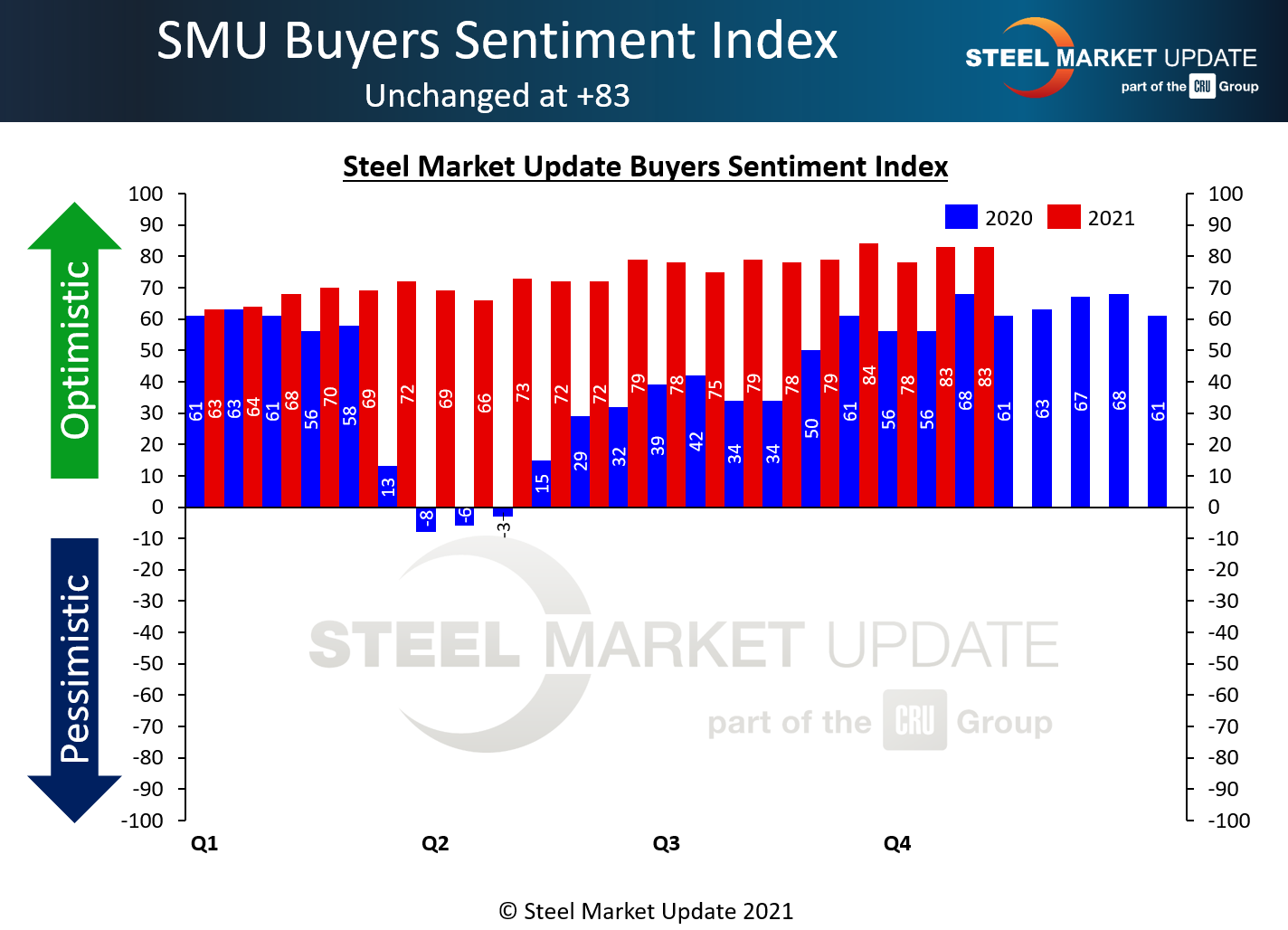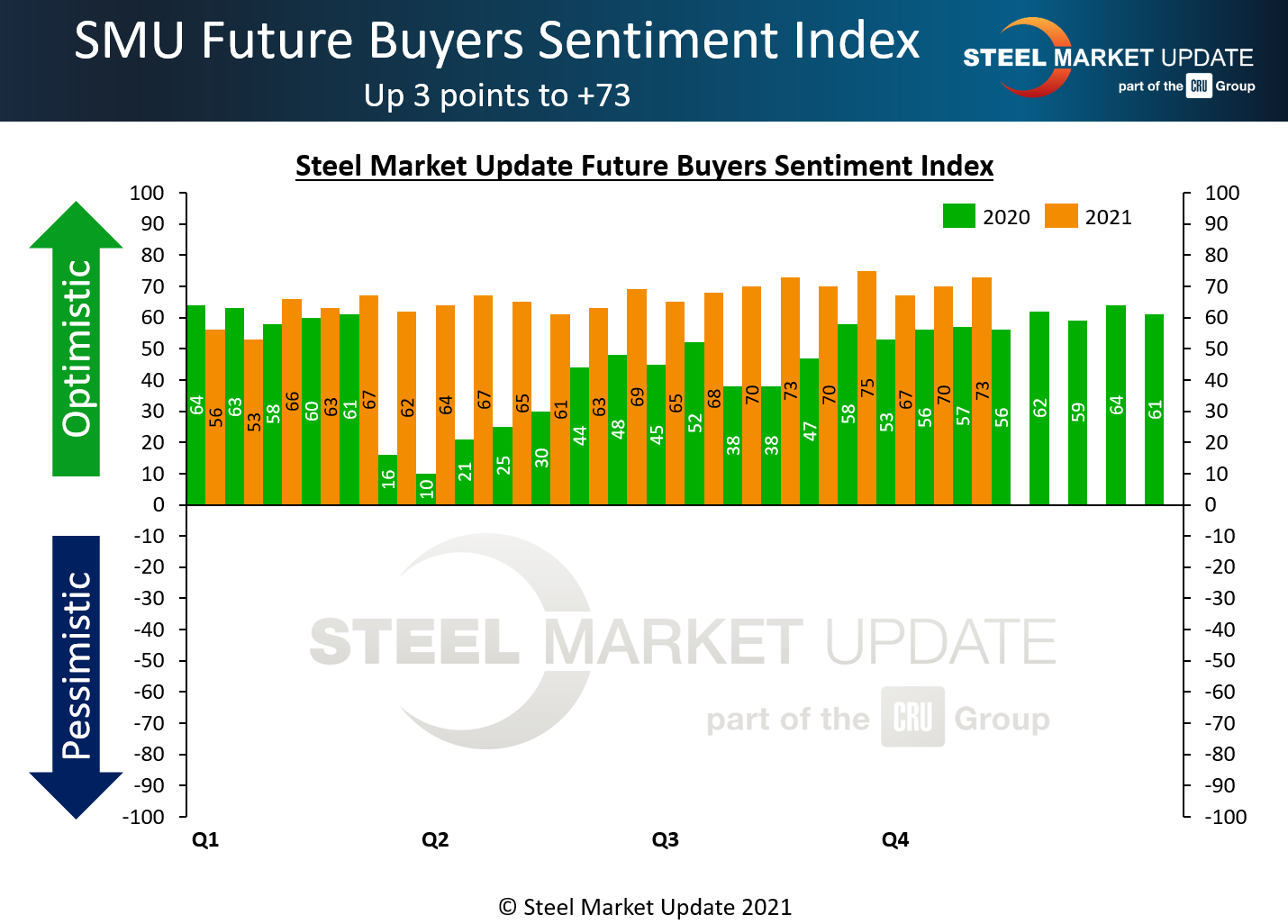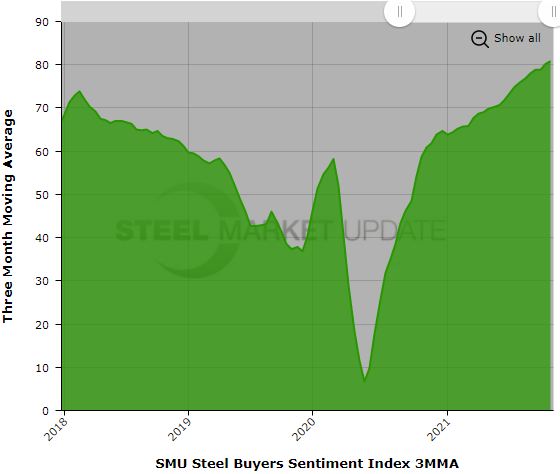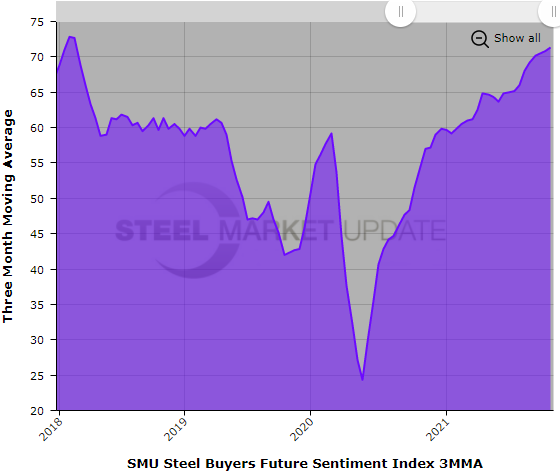SMU Data and Models

SMU Steel Buyers Sentiment: Optimism Belies Price Declines
Written by Tim Triplett
October 14, 2021
Sentiment among steel buyers tends to mirror steel prices. The higher the steel price, the higher the spirits of service center and manufacturing executives and the more optimistic they feel about their prospects. Steel Market Update data shows that the record-high steel prices of the past year have begun to moderate. But Steel Buyers Sentiment has not followed suit, at least not yet.
SMU polls buyers every two weeks and asks how they view their chances of success in the near and longer term. SMU’s Current Buyers Sentiment Index was unchanged this week at a reading of +83, just one point below its all-time high set on Sept. 2.
Similarly, Future Sentiment moved up three points to +73 this week. The index, which measures steel buyers’ feelings about their prospects three to six months in the future, remains near its all-time high of +77 seen in February 2018.


Measured as a three-month moving average (3MMA) to smooth out the variability, Current Sentiment stood at a new all-time high of +80.83 this week. The Future Sentiment 3MMA moved up to +71.33, its highest since February 2018.


There has been much debate about whether steel prices are poised to plummet or whether they will experience a gradual correction over the next few months. Judging by steel buyers’ attitudes—which remain as bullish as ever—steel prices may have more staying power than many predict.
What Respondents Had to Say
“Our prospects are good overall, but some headwinds and uncertainty will make it a challenge.”
“As we chased prices up, we will chase them down. It’s clear a correction on price will happen. As long as demand is strong we can be successful. Changes in trade tariffs could be an issue, especially how Section 232 is handled.”
“We have good quality, attractively priced imports coming in. We’re going very light with domestics in the first half.”
“We’ll continue setting records. Without a doubt, this will be our most profitable Q4 in company history.”
About the SMU Steel Buyers Sentiment Index
SMU Steel Buyers Sentiment Index is a measurement of the current attitude of buyers and sellers of flat-rolled steel products in North America regarding how they feel about their company’s opportunity for success in today’s market. It is a proprietary product developed by Steel Market Update for the North American steel industry.
Positive readings run from +10 to +100. A positive reading means the meter on the right-hand side of our home page will fall in the green area indicating optimistic sentiment. Negative readings run from -10 to -100. They result in the meter on our homepage trending into the red, indicating pessimistic sentiment. A reading of “0” (+/- 10) indicates a neutral sentiment (or slightly optimistic or pessimistic), which is most likely an indicator of a shift occurring in the marketplace. Sentiment is measured via Steel Market Update surveys that are conducted twice per month. We display the meter on our home page for all to see.
We currently send invitations to participate in our survey to more than 600 North American companies. Our normal response rate is 100-150 companies. Approximately 40 percent are manufacturers, 45 percent are service centers/distributors, and 15 percent are steel mills, trading companies or toll processors involved in the steel business.
Click here to view an interactive graphic of the SMU Steel Buyers Sentiment Index or the SMU Future Steel Buyers Sentiment Index.
By Tim Triplett, Tim@SteelMarketUpdate.com

Tim Triplett
Read more from Tim TriplettLatest in SMU Data and Models

SMU’s June at a glance
A look at SMU data for the month of June.

SMU Survey: Buyers’ Sentiment rebounds from multi-year low
Both of SMU’s Steel Buyers’ Sentiment Indices edged higher this week. Current Sentiment rebounded from a near five-year low, while Future Sentiment rose to a two-month high

SMU flat-rolled market survey results now available
SMU’s latest steel buyers market survey results are now available on our website to all premium members.

SMU Survey: Sheet lead times pull back after early-June blip, plate holds
Following the uptick seen two weeks ago, lead times eased this week for all four sheet products tracked by SMU, while plate lead times held steady, according to this week’s market survey.

SMU Survey: Pricing power abruptly shifts to steel buyers
The majority of steel buyers responding to our latest market survey say domestic mills are more willing to talk price on sheet and plate products than they were earlier this month. Sheet negotiation rates rebounded across the board compared to early June, while our plate negotiation rate hit a full 100%.
